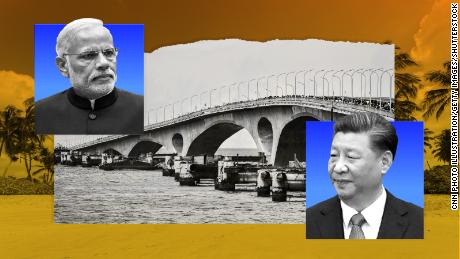A tale of two bridges: India and China vying for influence in the Maldives
In the heart of the Indian Ocean, a 2.1-kilometer (1.3-mile) bridge snakes out of an idyllic atoll, linking the Maldives' capital Malé with its international airport.
The China-Maldives Friendship Bridge, built with $200 million largely funded by Beijing, is among a growing list of Chinese projects in the tropical South Asian nation popular for its white sand beaches and turquoise lagoons.
But China's expanding footprint in the Maldives has unsettled neighboring India, which views the region as part of its traditional sphere of influence -- and at risk of being pulled away from its orbit.
In a move widely seen as an attempt to counter growing Chinese influence, India announced in August a $500 million package for its own bridge. Billed "the largest civilian infrastructure project" to be built in the Maldives, the 6.7-kilometer (4.1-mile) bridge and causeway will link Malé with three nearby islands, overshadowing the Chinese bridge in length, scale and price.
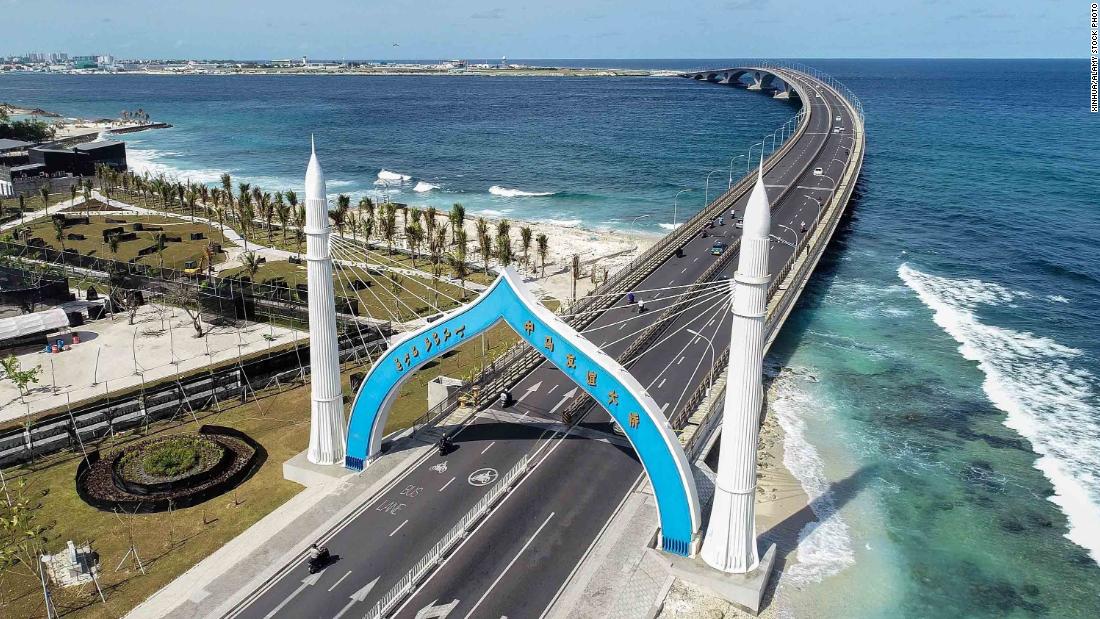
Completed in 2018, the China-Maldives Friendship Bridge is the flagship project of China's infrastructure boom in the Maldives.
The infrastructure race is another measure of the escalating geopolitical rivalry between India and China. In recent months, conflicts have flared along their disputed borders high in the Himalayas. Tension has also been building in the Indian Ocean, with New Delhi wary of Beijing's inroads into its backyard.
Under its former strongman president, Abdulla Yameen, who took power in 2013, the Maldives turned away from New Delhi and grew closer to Beijing, receiving hundreds of millions of dollars of Chinese funds to develop its coral islands. But Yameen's surprise election defeat in late 2018 gave India an opportunity to mend relations with its traditional ally, which owes China between $1.5 billion and $3 billion.
"For India, there are a lot of worries in regard to China," said Manoj Joshi, a distinguished fellow at the Observer Research Foundation, a New Delhi-based think tank.
"The Maldives is just too important for us," he added, citing its proximity to India's western coast. "There's nothing India can do in the Maldives to affect Chinese security, but there's a lot the Chinese can do in the Maldives to affect Indian security."
Shifting relations
An archipelago of nearly 1,200 low-lying coral islands and fewer than half a million people, the Maldives is the smallest Asian country by both land size and population. But it spreads over a swathe of strategically important waters and shipping lanes in the Indian Ocean.
By some estimates, half of India's external trade and 80% of its energy imports transit the sea lanes near the Maldives. China's crude oil imports from the Middle East and Africa -- which as of last year accounted for 62% of its total imports -- also travel along these routes.
Given their geographic proximity and strong historic and economic ties, India was for decades the Maldives' closest ally. It was one of the first countries to recognize Malé after it gained independence from the British in 1965. It also helped foil a coup attempt against the country's longtime dictator Maumoon Abdul Gayoom in 1988, sending in paratroopers to rescue Gayoom and restore order. And in 2004, India dispatched three navy vessels to bring aid to the Maldives following the Indian Ocean tsunami.
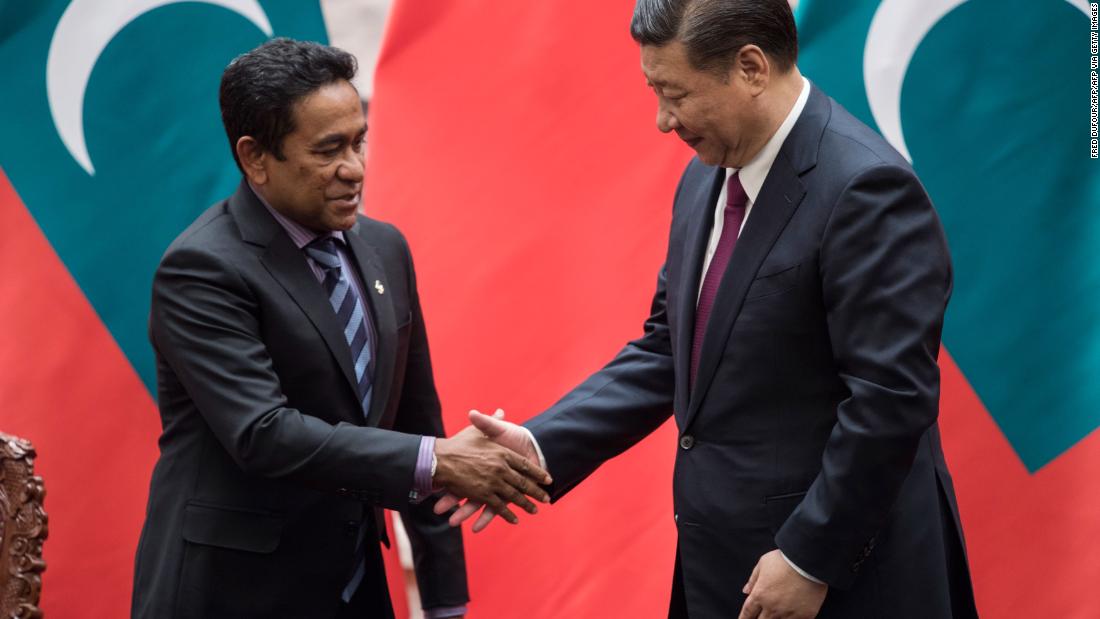
Former Maldives President Abdulla Yameen (L) shakes hand with Chinese President Xi Jinping after a signing ceremony at the Great Hall of the People in Beijing in December 2017.
But ties soured after Yameen -- an estranged half-brother of Gayoom -- came to power in 2013 in a disputed election. Domestically, Yameen was accused of eroding the Maldives' young and fragile democracy, as he cracked down on dissent, seized control of state institutions and jailed opposition leaders. On foreign policy, the authoritarian leader steered Malé away from Delhi and towards Beijing, courting Chinese investment under the Belt and Road Initiative (BRI) -- a trillion-dollar global infrastructure program announced shortly before Yameen took office.
Before late 2011, Beijing didn't even have an embassy in Malé. But under the BRI, the Maldives rose to prominence as an "important link" in the Maritime Silk Road -- an ancient sea route connecting China with Europe and Africa.
In 2014, Chinese President Xi Jinping made the first visit by a Chinese head of state to the island nation, paving the way for a slew of Chinese investment projects that would break ground in the following years, including the $800 million expansion of its international airport in 2016, a public housing project of 7,000 apartments on the reclaimed island of Hulhumalé near Malé, and, of course, the China-Maldives Friendship Bridge.
Chinese bridge
Completed in 2018, the bridge was hailed by Yameen as a "milestone" in the countries' bilateral relations.
"We appreciate the assistance provided by the Chinese government, which has made the dream of the Maldivian people a reality," Yameen said at the bridge's opening ceremony -- an evening of fireworks and music he officiated with a special envoy sent by Beijing.
The idea of a cross-sea bridge between Malé and the airport island of Hulhulé was first announced as a campaign pledge by Gayoom in 2008, when he sought to extend a three-decade hold on power in the country's first free presidential elections. The bridge would link Malé not only to the airport, but also the adjacent residential island of Hulhumalé.
Confined to an island smaller than New York's Central Park, Malé is home to some 150,000 residents -- roughly a third of the country's population -- making it one of the most densely populated cities in the world. Gayoom launched Hulhumalé, a massive land reclamation project, to ease overcrowding in the capital in 1997. It is now home to 50,000 residents, and is planned to eventually accommodate 240,000 people.
For years, the only way to go between the two islands was by ferry. During peak commuter times, queuing for the 20-minute ride from Hulhumalé to work on Malé could take hours. Yet while some Maldivians welcomed the convenience of a bridge, others questioned its technical and economic feasibility. The bridge would have to stand on fragile coral reefs, and opponents argued that its construction cost could never be recovered through a toll.
Ultimately, Gayoom couldn't build the bridge, losing the 2008 election to Mohamed Nasheed, a political activist who had spent long periods in jail under Gayoom's autocratic rule. Instead, Nasheed's government started construction in 2011. But that plan fell through, too, and just two months after the announcement, Nasheed was forced to resign in what he described as a coup by the military and police -- a claim later refuted by a Commonwealth-backed inquiry.
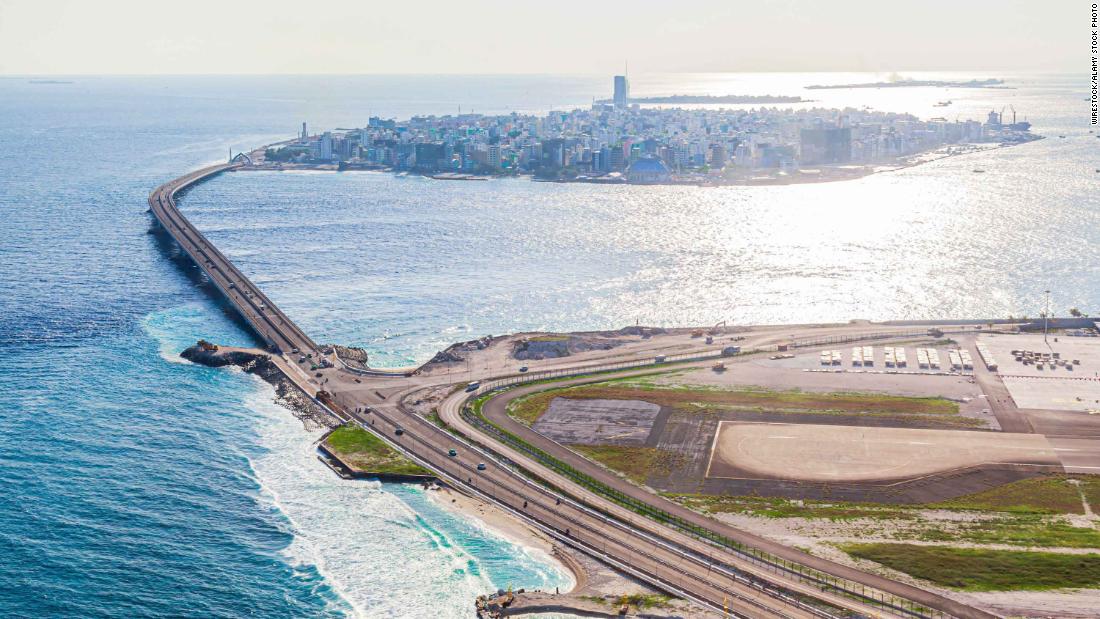
The China-Maldives Friendship Bridge connects Malé with Hulhule and Hulhumalé islands.
The bridge was finally built under Yameen, with Chinese money, workers and technical know-how. It ended up costing $200 million, with China providing $116 million in grants and $72 million in loans, and the rest paid by the Maldivian government.
Now, it only takes a matter of minutes to drive across the bridge and commute between Malé and Hulhumalé.
Zimaam, a former Malé resident and construction worker, moved to Hulhumalé after the bridge opened in 2018. He now owns a motorbike repair garage in Hulhumalé. Business is good, he said, and he still goes to Malé daily to buy supplies.
"Before we had to travel by ferry and it cost more money," he said. "Now with the bridge it's much easier."
Mounting debt
Chinese infrastructure projects like the bridge, however, have also left behind a mountain of debt.
After incumbent President Ibrahim Mohamed Solih took office in November 2018, his government had a hard time figuring out how much the Maldives owed China. Its central bank governor believed the government directly owed $600 million to Beijing, but there was also $900 million in loans issued to Maldivian companies under sovereign guarantees -- which the Maldivian government would be obliged to pay back if borrowers default on their loans.
"There were a lot of concerns about ... the ability of the Maldives to repay these loans to China, that a lot of these loans were for projects which were not necessarily very economically feasible, or which had been obtained by Chinese companies under very questionable circumstances," said David Brewster, a senior research fellow at the National Security College of the Australian National University.
Yameen, who was sentenced to five years in prison last November for money laundering, is accused by the new government of signing Chinese investment contracts at inflated prices. An investigation into the deals for alleged corruption is now underway.
China's foreign ministry says the projects are "based on Maldives wishes and needs for development" to "enhance the well-being of the Maldivian people."
Former President Nasheed, now leader of Solih's ruling Maldivian Democratic Party, said the country's China debt could run as high as $3 billion -- or more than half of the country's GDP. Chinese officials have denied this, calling the figure "deeply exaggerated."
With the coronavirus pandemic bringing international tourism to a halt, those debts are further straining the Maldives' small economy.
The World Bank expects the Maldives to be the hardest-hit South Asian nation by the pandemic, with a projected 19.5% contraction in GDP this year. In April, the International Monetary Fund said the Maldives was at "high risk" of debt distress, with China accounting for 53% of its external debt.
Maldivian officials have tried to renegotiate the debts with China. In September, Chinese Ambassador to the Maldives Zhang Lizhong said on Twitter that Beijing had suspended the bilateral sovereign loans for the Maldives under the G20's debt service suspension initiative.
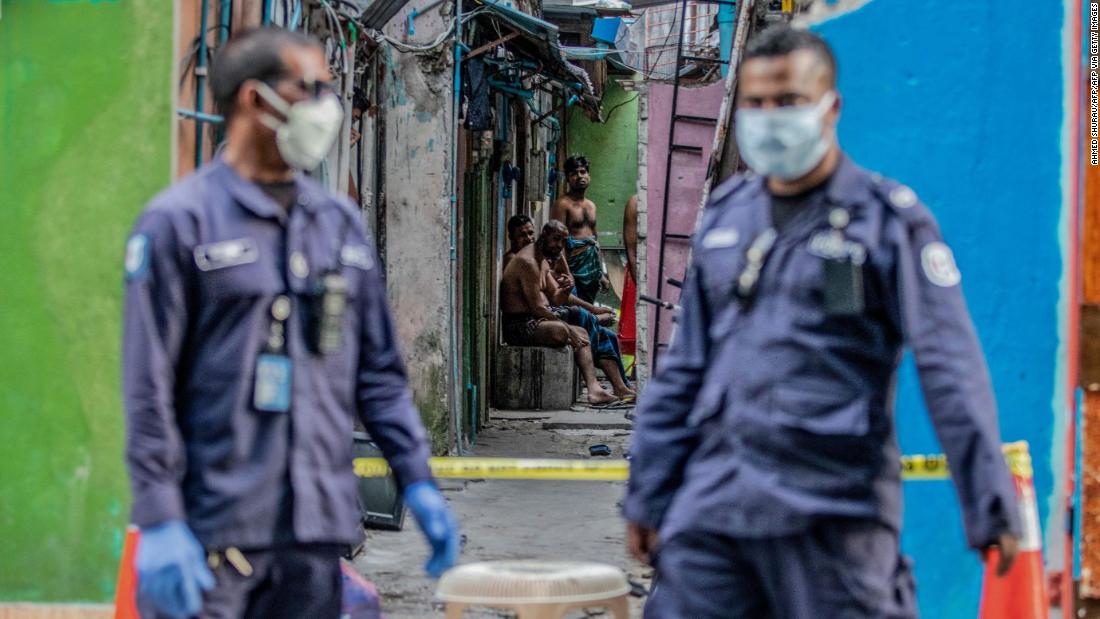
Security personnel in Malé stand guard outside a residential area for Bangladeshi workers, who were placed under coronavirus quarantine in May.
But the suspension does not apply to the hundreds of millions of dollars of debt held by Maldivian companies under sovereign guarantee. In July, Maldivian media reported that China's Exim Bank ordered the Maldivian government to repay $10 million after Ahmed Siyam, a resort tycoon and close ally of Yameen, defaulted on payments for a $127 million sovereign-guaranteed loan granted to his business three years ago. That loan is controversial in itself -- it is highly unusual for a private company to receive a sovereign guarantee, which is usually granted to the state sector.
Amid fears of a sovereign default, the Maldivian finance ministry announced in August that Siyam's company had paid back the loan in full. But analysts say the incident remains a warning of the risks of taking on billions of dollars in debt to China.
According to Nasheed, the Maldives needs to repay $83 million to China by the end of this year, and another $320 million in 2021. He said 53% of the Maldives' government revenue next year will be used for debt repayment -- of which more than 80% will go to China.
"Totally unaffordable," Nasheed wrote on Twitter this week. "Even if we sell our grandmother's jewelry, we won't be able to afford these repayments."
China's foreign ministry said Beijing had "always attached great importance to the sustainability of Maldives' debt."
"China has made appropriate arrangements for issues relating to loan interest rates, repayment periods and grace periods from the beginning of the negotiations on related cooperation," it said in a statement Monday. "It should be pointed out that the current debt repayment obligations of Maldives mainly come from other bilateral and multilateral financial institutions, not China."
Warming ties
Under the new government, the Maldives has increasingly looked to India, with Delhi equally eager to repair bilateral ties. According to India's foreign ministry, Delhi's total pledged financial assistance to the Maldives has surpassed $2 billion since Solih came to power.
"It is really quite unprecedented for India, in terms of the scale of the assistance and also the speed in which it has been deployed," Brewster said. "It points to a view in Delhi about the importance of the Maldives, that India needs to spend whatever it takes to secure its position there."
A month into Solih's term in office, Indian Prime Minister Narendra Modi announced $1.4 billion financial assistance to the Maldives amid worries over its soaring Chinese debts. And in August this year, India announced a $500 million package to fund the Greater Malé Connectivity Project, linking Malé to the islands of Vilingili, Gulhifalhu and Thilafushi through a series of bridges and causeways. The package consists of a $100 million grant and a $400 million soft loan, or line of credit. According to India's Exim Bank, this type of soft loans are issued to the Maldives at a low interest rate of 1.75%, with a credit period of 20 years. In addition, India pledged $250 million of budgetary support to the Maldives to boost its coronavirus-battered economy.
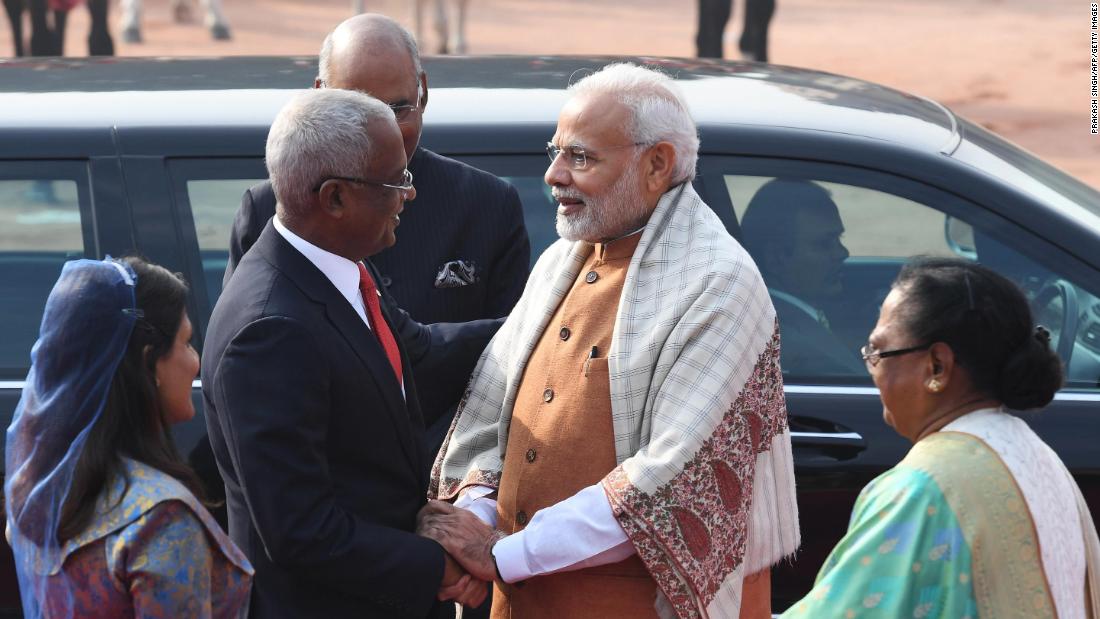
Indian Prime Minister Narendra Modi welcomes Maldives President Ibrahim Mohamed Solih in New Delhi in December 2018.
Nasheed described the financial package as "super low cost development assistance," which he said was "exactly what (the) Maldives needs."
"Genuine help from a friend, to help us build critical infrastructure. Rather than eye-wateringly expensive commercial loans that leaves the nation mired in debt," he said on Twitter.
An array of Indian funded infrastructure projects are already underway in the Maldives, including a cricket stadium and a hospital in Hulhumalé, a $300 million port project on Gulhifalhu, the redevelopment of an airport at Hanimaadhoo, and water and sewerage projects on 34 islands.
While loans for infrastructure projects might look similar to Chinese investment, Nasheed says a key difference is transparency. "There's no tendering process," he said of the Chinese projects. "The Maldives has no say in who gets the contract, or how much the price is."
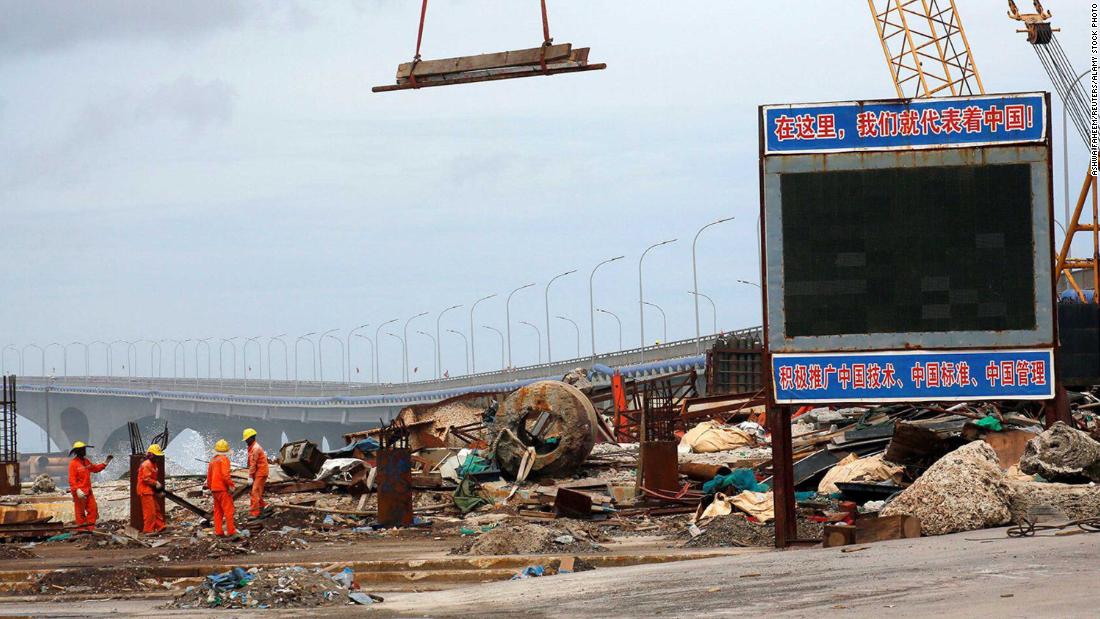
A signboard at the construction site of the China-Maldives Friendship Bridge reads: "Here, we represent China!"
The Maldives has much more control over Indian-funded projects, Nasheed said. "The tendering process happens here, the award (of contract) happens here, the monitoring happens here, and the labor can come from here," he added. "It really sinks into our economy."
But Joshi, from the Observer Research Foundation, said there is a limit to the amount of infrastructure investment and financial aid India can offer its island neighbor.
The Indian economy has suffered a devastating blow from the coronavirus pandemic. Following a nationwide lockdown, its GDP contracted 23.9% from April to June -- its biggest slump on record. According to a World Bank report in July, about half of India's population is at risk of slipping back into poverty due to income and job losses.
"The Indian economy is less developed (than China's). If you're going to be developing infrastructure (in the Maldives), people would say, 'What about here?'" Joshi said.
Balancing act
While leaning closer to India, analysts said the Maldives cannot afford to alienate Beijing -- partly due to the large amount of debt it owes and its reliance on China for income. China is the largest source of tourists to the Maldives, and a key market for the recovery of its tourism sector after the pandemic.
Solih's government has repeatedly assured Beijing of its commitment to maintaining good relations.
"China has been and will continue to remain as an important economic and bilateral development partner of the Maldives," Maldivian Foreign Minister Abdulla Shahid said in an interview with Xinhua in July.
Brewster said the Maldives was likely to welcome further Chinese investment in the future, provided it was not in areas seen as too politically controversial.
At the same time, the Maldives is reaching out to countries like the US and Japan.
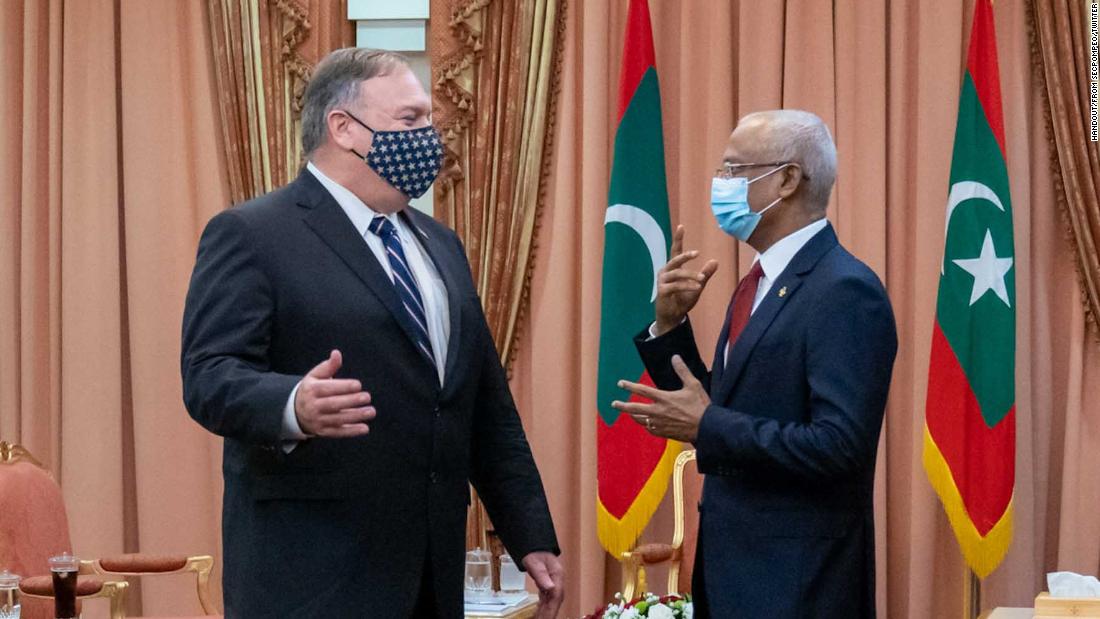
On October 28, US Secretary of State Mike Pompeo tweeted this image following his meeting with Maldives President Ibrahim Mohamed Solih.
In September, Japan extended a $47.5 million loan to support the Maldives in the Covid-19 crisis, the largest concessional loan it has ever given the island nation. And last month, during a five-day tour in South and Southeast Asia, Secretary of State Mike Pompeo announced the US would open an embassy in Malé. The announcement came after the US and the Maldives signed a defense agreement in September.
"These are all actions by like-minded countries to support India's position and to ensure that the Maldives government doesn't come under undue influence from Beijing," Brewster said.
The growing rivalry between India and China means the Maldives will need to tread carefully to maintain good relations with both Asian giants.
Yet Nasheed said there was no question which one will be the priority.
"We have no intention of severing our relations with China. But because we're a center-right democratic party, we like like-minded friends -- and we believe India is the biggest democracy," he said.
"It's India first. We always say that."
News Courtesy: www.cnn.com

